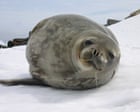Antarctic seal populations are drastically declining as the sea ice melts around them, new research has shown.
Researchers from theBritish Antarctic Survey(BAS) have been monitoring the seal population in the sub-Antarctic since the 1970s, looking in particular at three different seal species in the sub-Antarctic on Signy Island: Weddell seals, Antarctic fur seals and southern elephant seals.
Using satellite records from as far back as 1982, the research team compared annual changes in sea ice concentration with seal population counts conducted since 1977. With five decades worth of data spanning a period of long-term warming and temporary cooling between 1998 and 2014, they were able to draw a comprehensive picture of how seal populations react to changing ice conditions, something shorter-term studies would not be able to achieve.
The study, published in the scientific journal Global Change Biology, found Weddell seals (leptonychotes weddellii), which rely on stable sea ice to rest, breed and feed, had declined by 54% since 1977. Similarly, Antarctic fur seals (arctocephalus gazella), which breed on land but are affected by food chain shifts, have declined by 47%.
The findings challenge previous assumptions that the population in the South Orkneys had stabilised.
Southern elephant seals (mirounga leonina), despite sharing similar population trends, presented “no significant overall long-term decline”.
The study serves to emphasise the “vital importance of long-term ecological monitoring” as well as the interconnectedness between the three species of seal and sea ice conditions. Michael Dunn, lead author of the study, said: “For once, we’re not just predicting how wildlife might respond to shrinking sea ice and environmental shifts, we’ve had the rare opportunity to confirm it, using solid, long-term data. The emerging picture is deeply concerning.”
Sign up toDown to Earth
The planet's most important stories. Get all the week's environment news - the good, the bad and the essential
after newsletter promotion
In light of the BAS’s findings, researchers have also raised concerns about how climate breakdown is affecting the Antarctic food web, relied on by all three species.
